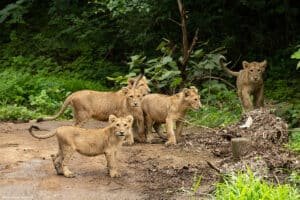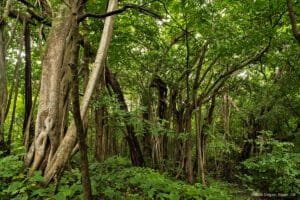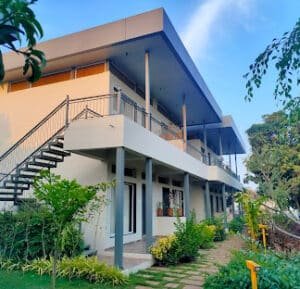Gir National Park

Situated on the Saurashtra peninsula near Talala Gir in Gujarat. It lies 43 km northeast of Veraval, 65 km southeast of Junagadh, and 60 km southwest of Amreli. Established in 1965 in the former private hunting area of the Nawab of Junagadh. Gir Forest (comprising Gir National Park and Sanctuary) has long been synonymous with the majestic Asiatic lions. This region is renowned for its incredible biodiversity of flora, fauna, and landscapes unique to the Indian subcontinent. The Gir ecosystem holds a special distinction for conserving the rare and endangered Asiatic lion, rescuing it from the brink of extinction in the early 19th century.
Home to more than 600 species of wild flora and fauna—including 41 species of mammals, 47 species of reptiles, and over 300 species of resident and migratory birds—Gir provides visitors with serene and breathtaking experiences amid its vast woodlands. The landscape, marked by rolling hills and rivers that originate within the forest, adds to its mystique. Each season brings new shades and tones to Gir, offering a fresh perspective and unique experience year-round. Revered as one of India's finest wildlife sanctuaries, Gir also serves as an important center for the cultural and religious development of Gujarat's Kathiawar region.
Geography:
Gir National Park, located on the Saurashtra peninsula in Gujarat, features a varied landscape of rugged ridges, plateaus, valleys, and isolated hills. Seven perennial rivers—Hiran, Shetrunji, Datardi, Shingoda, Machhundri, Godavari, and Raval—flow through the area, supporting the forest ecosystem. Four reservoirs, formed by dams on the Hiran, Machhundri, Raval, and Shingoda rivers, provide water throughout Gir. The Kamleshwar Dam on the Hiran River, the largest in the region, is known as the “lifeline of Gir” for its role in sustaining wildlife, including marsh crocodiles. The park spans 1,412 sq km, with elevations ranging from 150 to 530 meter.
Flora (plants)
Gir National Park’s 1955 survey by Samtapau and Raizada recorded over 400 plant species, later revised to 507 species by M.S. University of Baroda. The forest is classified as 5A/C-1a—very dry teak forest, with teak mixed with dry deciduous species, including dry deciduous scrub and savannah forests (“vidis”). Teak dominates the eastern portion, alongside species like acacia, ber, jamun, babul, flame of the forest, zizyphus, tendu, dhak, karanj, umlo, amli, sirus, kalam, and banyan trees. Casuarina and prosopis have been planted along borders for afforestation. Claims about 5 million kg of green grass (valued at ₹500 million or US$7.12 million) and 123,000 metric tons of fuelwood.

Wild life (Animals)
Gir National Park supports approximately 38 mammal species, 300 bird species, 37 reptile species, and over 2,000 insect species. Key species include:
Carnivores: Asiatic lion, Indian leopard, jungle cat, striped hyena, golden jackal, Bengal fox, Indian gray mongoose, ruddy mongoose, honey badger, Asiatic wildcat, and rusty-spotted cat (rare).
Herbivores: Chital, nilgai, sambar, four-horned antelope, chinkara, wild boar, and occasional blackbucks.
Reptiles: Mugger crocodile, Indian cobra, tortoise, monitor lizard, and pythons
Birds: Over 300 species, including crested serpent eagle, Bonelli’s eagle, changeable hawk-eagle, brown fish owl, Indian eagle-owl, rock bush-quail, Indian peafowl, brown-capped pygmy woodpecker, black-headed oriole, crested treeswift, Indian pitta, and vulture species (likely including white-backed vulture and others)
Indian Crocodile Conservation Project: Initiated in 1975, it released approximately 1,000 mugger crocodiles into Kamleshwar Lake and other water bodies in and around Gir National Park.

Gir National Park Lions Population in Gir National Park (1968–2025)
The table below summarizes the Asiatic lion population in Gir National Park based on censuses conducted by the Gujarat Forest Department. Data includes total counts and breakdowns by males, females, cubs, and sub-adults where available.
| Year | Total Count | Males | Females | Cubs | Sub-adults |
|---|---|---|---|---|---|
| 1968 | 177 | – | – | – | – |
| 1974 | 180 | – | – | – | – |
| 1979 | 261 | 76 | 100 | 100 | – |
| 1984 | 252 | 88 | 100 | 64 | – |
| 1990 | 249 | 82 | 100 | 67 | – |
| 1995 | 265 | 94 | 100 | 71 | – |
| 2000 | 327 | 99 | 115 | 76 | – |
| 2005 | 359 | – | – | – | – |
| 2010 | 411 | 97 | 162 | 152 | – |
| 2015 | 523 | 109 | 201 | 213 | – |
| 2020 | 674 | 274 | 260 | 137 | – |
| 2025 | 891 | 196 | 330 | 225 | 140 |
- The 2025 census specifies 365 young lions, comprising 140 sub adults and 225 cubs.
- Source: Gujarat Forest Department census reports.
Historical Range of the Asiatic Lion
Historically, Asiatic lions had a broad distribution across,Middle East and Indian Subcontinent: From West Asia to India, including northern and central Indian states such as Haryana, Punjab, Uttar Pradesh, Bihar, Madhya Pradesh, and Rajasthan.
Due to habitat loss and hunting, their range shrank significantly, restricting them to the Saurashtra region of Gujarat by the early 20th century. Gir National Park and its surrounding areas now serve as their last natural habitat.
Current Habitat of the Asiatic Lion
Asiatic lions currently inhabit the Saurashtra region of Gujarat, thriving in a landscape of dry deciduous forests and grasslands. Their primary habitat spans the following districts: Junagadh, Gir Somnath, Amreli, Bhavnagar.
Official records confirm lion presence in these core districts, with occasional sightings in adjacent areas due to population dispersal. The habitat is supported by seven perennial rivers—Hiran, Shetrunji, Datardi, Shingoda, Machhundri, Godavari, and Raval—and reservoirs like the Kamleshwar Dam on the Hiran River, which is critical for sustaining wildlife.
Source: Gujarat Forest Department (girlion.gujarat.gov.in)
Conservation Status and Achievements
The Asiatic lion is listed as Endangered on the IUCN Red List, but its population has shown significant growth due to robust conservation efforts by the Gujarat Government and Forest Department. Key points include:
Population Growth:
The 2020 Asiatic Lion Census, conducted by the Gujarat Forest Department, recorded 674 lions, up from 523 in 2015, demonstrating steady population growth.
Asiatic lion conservation:
The Gujarat Forest Department has implemented measures like anti-poaching patrols, habitat management, and community engagement programs to protect lions.The Sakkarbaug Zoo in Junagadh supports a breeding program to bolster the lion population.
Community Role:
Local communities, including the Maldhari pastoralists, coexist with lions, supporting conservation through ecotourism and conflict mitigation initiatives.
Ecological Problems
- Natural: Recurrent droughts, cyclones, and forest fires.
- Anthropogenic: Overgrazing, encroachment, excessive traffic, weed infestation, tourism-related degradation, peripheral mining, and pollution from nearby railway lines.
- Genetic: Narrow genetic base in large mammals, raising concerns about long-term viability.
Gir National park Tourism
Gir National Park is a renowned wildlife sanctuary in Gujarat, celebrated for its thriving population of Asiatic lions and diverse wildlife including leopards, chital, nilgai, and more than 300 species of birds. The optimal period to visit is between November and March, when the weather is cooler and wildlife activity peaks, providing excellent opportunities for sightings. Safari bookings can be made online at girlion.gujarat.gov.in, which is recommended for an effortless and regulated experience. The Gir Interpretation Zone at Devalia offers a controlled environment where sightings of lions and leopards are almost guaranteed, making it ideal for families and first-time visitors.
The park also maintains strict conservation policies, ensuring only limited vehicles and visitors per safari to minimize ecological impact and preserve the delicate sanctuary environment. Guided jeep safaris allow visitors to explore different forest trails, observe a range of flora and fauna, and appreciate the dry deciduous landscape unique to Gir. The sanctuary is closed during the monsoon season from June to mid-October; however, the Devalia Interpretation Zone remains open year-round, offering wildlife experiences even when the main park is inaccessible. In addition to wildlife safaris, visitors can enjoy attractions like the Kamleshwar Dam, crocodile breeding centers, and bird-watching spots, making a visit to Gir a rich ecotourism experience for all ages.

Best Time to Visit Gir National Park
Gir National Park, situated in Gujarat's Junagadh district, has a tropical climate with distinct seasonal variations. From April to June, the park experiences intense heat with significantly high temperatures. In contrast, the period from November to February offers cool and pleasant weather, making it the ideal time for visitors. December stands out for its particularly chilly conditions, attracting a large number of tourists to the park during this peak season.
Distance Details
The table below lists the approximate road distances from various destinations to Sasan-Gir (Gir National Park) in Gujarat, India.
| Destination | Distance (km) |
|---|---|
| Veraval – Sasan-Gir | 45 |
| Junagadh – Sasan-Gir | 60 |
| Diu – Sasan-Gir | 100 |
| Rajkot – Sasan-Gir | 160 |
| Ahmedabad – Sasan-Gir | 370 |
Notes:
- Distances are approximate and may vary slightly depending on the route taken.
Gir National Park Safari Timetable
The table below lists the safari timings for Gir National Park Safari in Gujarat, India, by season.
| Season | Days | Morning Timings | Evening Timings |
|---|---|---|---|
| Winter (16 October to 28/29 February) | Monday to Sunday | 6:45 AM to 9:45 AM | 3:00 PM to 6:00 PM |
| Winter/Summer | Monday to Sunday | 9:00 AM to 12:00 PM | – |
| Summer (1 March to 15 June) | Monday to Sunday | 6:00 AM to 9:00 AM | 4:00 PM to 7:00 PM |
Notes:
- Gir Jungle Safari is closed from 16 June to 15 October every year due to the monsoon season.
Gir Jungle Safari Permit Charges
The table below lists the permit charges for Gir Jungle Safari in Gujarat, India, covering up to 6 persons plus one child (aged 3–12 years). Charges vary for Indian and foreign visitors and by day type.
| Vehicle Type | Days | Particulars | Indian (₹) | Foreigner (₹) |
|---|---|---|---|---|
| Safari Vehicle | Monday to Friday | Up to 6 persons | 800 | 6560 |
| Safari Vehicle | Monday to Friday | Extra Child (3–12 years) | 100 | 1640 |
| Safari Vehicle | Saturday, Sunday, Festival Days | Up to 6 persons | 1000 | 8200 |
| Safari Vehicle | Saturday, Sunday, Festival Days | Extra Child (3–12 years) | 125 | 2050 |
Notes:
- Each e-permit covers a maximum of 6 persons plus one child (aged 3–12 years).
- Permit charges exclude guide and vehicle fees, which must be paid separately to respective guides and vehicle owners.
- Safari vehicle charges: 4-seater (₹2500), 6-seater (₹3500), 8-seater (₹4500).
- Camera fees may apply: ₹100–₹200 for Indians, ₹1000–₹2000 for foreigners.
- Source: Gujarat Forest Department (girlion.gujarat.gov.in).
Gir National Park Hotels and Staying Facility
- The Postcard Gir Wildlife Sanctuary

- Type: Luxury Resort
- Description: Located amidst 16 acres of mango orchards, this resort offers 15 private rooms, an outdoor pool, and exceptional hospitality. Guests praise the attention to detail, delicious food (Gujarati thali, Parsi dishes), and safari arrangements with extras like binoculars and hats. Ideal for a premium, nature-centric stay.
- Recent Review Highlights: Guests highlight the 7-star experience, excellent staff, and lion sightings on safaris.
Booking Link: The Postcard Gir Wildlife Sanctuary
Price Range: Approx. INR 20,000–30,000 per night (varies by season)
2. The Fern Gir Forest Resort

- Type: Luxury Resort
- Description: A modern resort in Sasan Gir with a spa, fitness center, outdoor pool, and an on-site restaurant serving Indian and Continental cuisine. Known for its spacious rooms and proximity to the park.
- Recent Review Highlights: Guests appreciate the well-maintained property, spacious rooms, and great ambiance (Tripadvisor, Feb 2024).
Booking Link: The Fern Gir Forest Resort
Price Range: Approx. INR 8,000–15,000 per night.
3.Hotel Anil Farmhouse Gir Jungle Resort

- Type: Budget/Mid-Range Resort
- Description: An eco-friendly property in a mango orchard by the Hiran River, offering an outdoor pool, garden, and family rooms. Guests enjoy organic food, campfires, and activities like African folk dance. Close to the crocodile farm and Hiran River.
- Recent Review Highlights: Clean rooms, excellent food, and a peaceful environment (Booking.com reviews).
Booking Link: Hotel Anil Farmhouse
4. Gir Jungle Lodge

- Type: Mid-Range Lodge
- Description: Located at the entrance of Gir National Park, this lodge offers comfortable accommodations with a high standard of service. The on-site restaurant is noted for its world-class offerings.
- Recent Review Highlights: Guests love the location and quality of service for an authentic Gir experience (girnationalpark.in).
Booking Link: Gir Jungle Lodge
Price Range: Approx. INR 4,000–8,000 per night.
5. Lion Signature Family Resort

- Type: Mid-Range Resort
- Description: Located in Sasan Gir, 27 miles from Somnath Temple, it features a garden, free parking, and a restaurant. Known for helpful staff and a family-friendly environment.
- Recent Review Highlights: Guests commend the staff’s assistance and comfortable facilities (Booking.com).
- Booking Link: Lion Signature Family Resort
- Price Range: Approx. INR 5,000–10,000 per night





